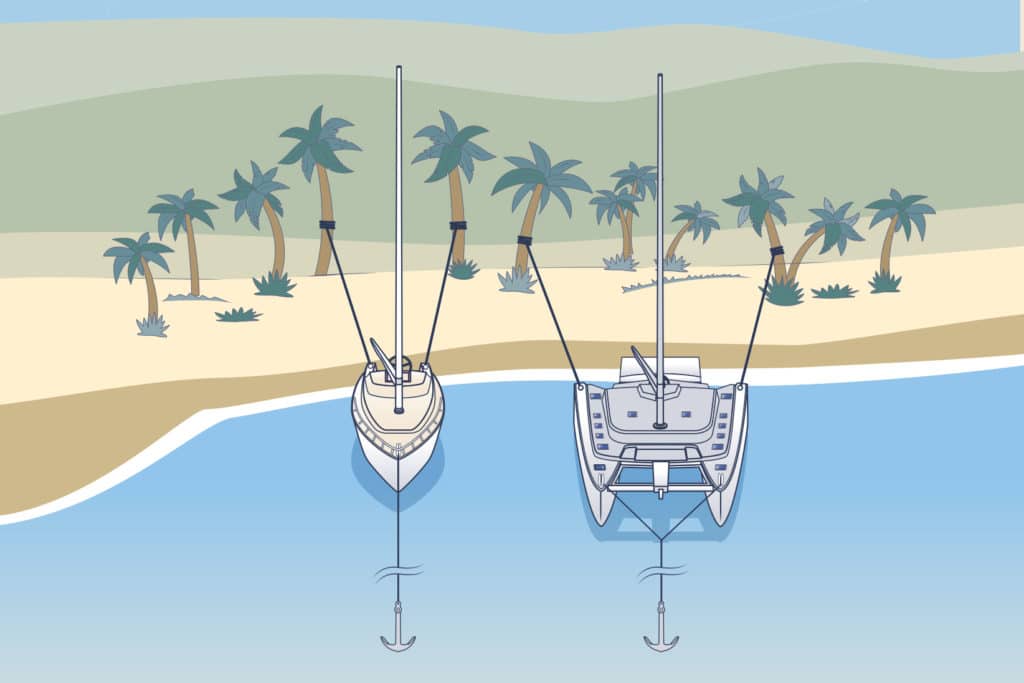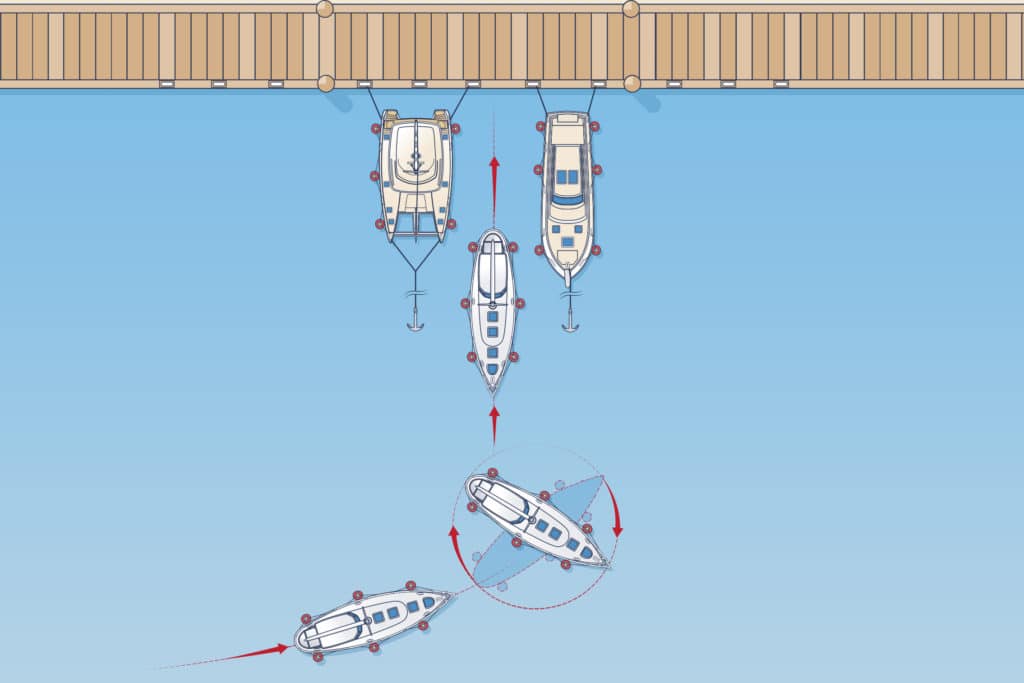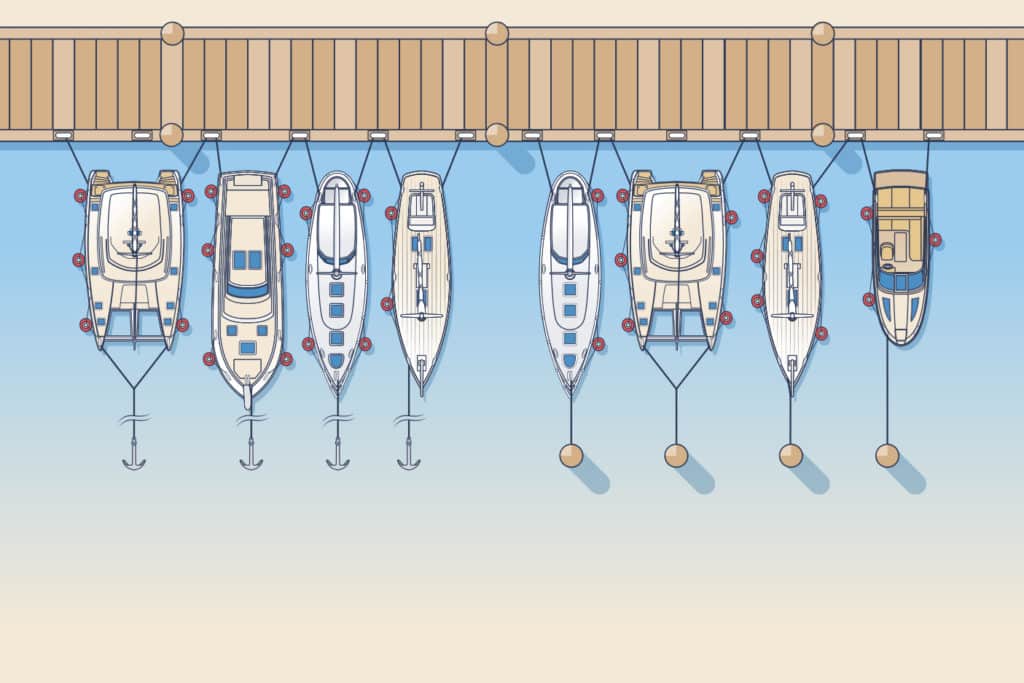
Mark, Sandy, and their sons, Simon and Owen, are preparing to make landfall after a long passage. According to the cruising guide, the harbor that will be their port of entry for clearing customs requires boats to tie up stern to to a quay, or Med-moor. This technique involves securing the boat perpendicular to the harbor wall using stern lines and ground tackle. As they enter the harbor, a call to the harbor master on the VHF gets them an assigned berth where a dockhand will help with their stern lines. Mark first makes a look-see pass to make sure they can fit between the boats adjacent to the berth. He also checks to see what type of cleats or bollards are on the quay, and he ensures that they will be able to drop anchor without crossing the rodes of other vessels. He finds that the wind and current are negligible.
After their pass by, Mark gets his crew together and explains the maneuver, assigning each person a task. Sandy coils the stern lines and readies them for heaving. Owen gets out the fenders and positions them both port and starboard with an additional one on the transom. Simon ensures that the anchor is ready to drop and pay out freely. Lastly, the dinghy is moved to the bow so it will be out of the way as they back in.
They head in, maintaining enough speed for maneuvering. As their berth comes abeam, Mark pivots the boat bow out and perpendicular to the quay. He signals Simon to lower the anchor in a position that should give adequate scope, in this case about four boatlengths off the quay.
AdvertisementAs Mark backs into the space between the other boats, Simon eases out the anchor rode, occasionally tugging on it to set the hook. Owen stands by with an extra fender, just in case.
When the stern is close enough, Sandy heaves the stern lines to the dockhand, who secures them at a wide angle to keep the stern centered. Mark signals Simon to secure the anchor rode, keeping the stern about 2 feet off the quay.
Once the boat has been safely tied up, Mark has his crew briefly ease the anchor line and route the stern lines so they run from each stern cleat to shore and around the bollards (or through rings) on the quay, and then back to the boat, where the lines are again tensioned and cleated off. This will make departing easier. The anchor rode is then re-tensioned. After clearing customs, Mark, Sandy and the boys can begin their shore-side adventures.
Although challenging, with practice and planning, the Med-moor maneuver can be very useful. In many areas, it is necessary. Increasing numbers of boats make Med-mooring an attractive choice for marinas with small tidal range, both saving the cost of finger floats and making much more efficient use of space. Whether anchoring against a steep drop-off shoreline and securing your stern to a palm tree, or taking a mooring over the bow and securing to a quay, the rewards of a maneuver well done are a satisfying part of the cruising life.

Tips for Tying Up
Be Flexible
Each time you Med-moor, you’ll face a different set of circumstances. Sometime you’ll tie to a wall, other times you’ll back up to a dock, and still other times you’ll want to approach a shoreline and take lines ashore to rocks or trees, in order to bring the bow closer to the beach or keep the stern and its running gear in deeper water.
Going it Alone
Singlehanded (and shorthanded) Med-mooring requires additional skill, and many boats are equipped with devices that can help. Being able to operate the anchor windlass with a remote control at the helm is an option that allows the singlehander to maneuver without having to go forward. Just before the stern contacts the quay, the anchor is checked, and the engine remains idling in reverse while the skipper tends to securing the stern. In a tight berthing situation, the adjacent boats ensure that the boat holds position. A bow thruster can be useful, especially with wind or current from abeam.

Earl MacKenzie is captain of the schooner Bonnie Lynn and a frequent CW contributor.








